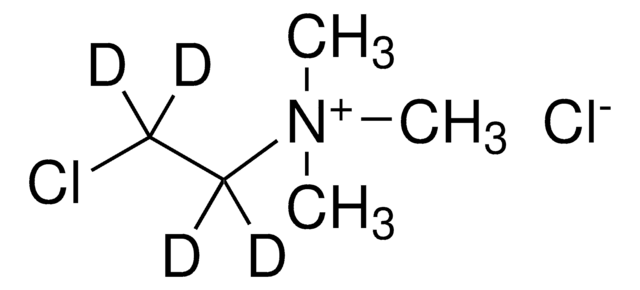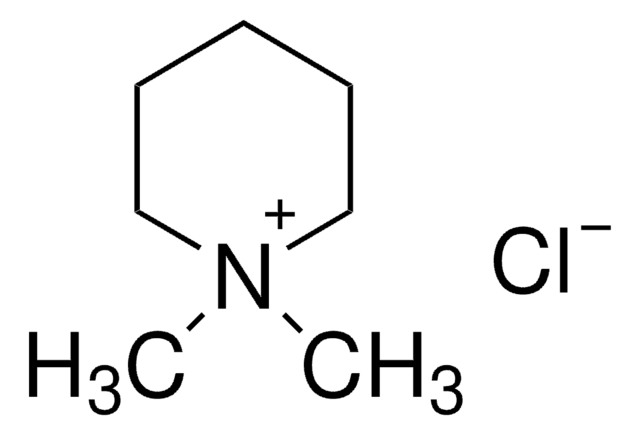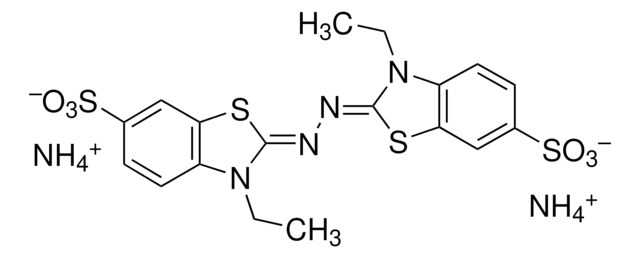93757
Chlormequat chloride
certified reference material, TraceCERT®, Manufactured by: Sigma-Aldrich Production GmbH, Switzerland
동의어(들):
Chlorocholine chloride, (2-Chloroethyl)trimethylammonium chloride, Chlormequat chloride, Choline dichloride
로그인조직 및 계약 가격 보기
모든 사진(1)
About This Item
Linear Formula:
(CH3)3N(Cl)CH2CH2Cl
CAS Number:
Molecular Weight:
158.07
Beilstein:
3563994
MDL number:
UNSPSC 코드:
41116107
NACRES:
NA.24
추천 제품
Grade
certified reference material
Quality Level
제품 라인
TraceCERT®
grade
TraceCERT®
유통기한
limited shelf life, expiry date on the label
제조업체/상표
Manufactured by: Sigma-Aldrich Production GmbH, Switzerland
SMILES string
[Cl-].C[N+](C)(C)CCCl
InChI
1S/C5H13ClN.ClH/c1-7(2,3)5-4-6;/h4-5H2,1-3H3;1H/q+1;/p-1
InChI key
UHZZMRAGKVHANO-UHFFFAOYSA-M
유사한 제품을 찾으십니까? 방문 제품 비교 안내
관련 카테고리
일반 설명
This certified reference material (CRM) is produced and certified in accordance with ISO/IEC 17025 and ISO 17034. This CRM is traceable to primary material from an NMI, e.g. NIST or NMIJ.
Certified content by quantitative NMR incl. uncertainty and expiry date are given on the certificate.
Download your certificate at: http://www.sigma-aldrich.com
Chlormequat chloride, also known as chlorocholine chloride (CCC) is the most widely used plant growth regulator that inhibits the biosynthesis of gibberellins. CCC is applied in agriculture and horticulture to promote sturdier growth by reducing the height of grain crops and increasing the diameter of the stems without causing a loss of plant productivity.
Chlormequat chloride has to be monitored in the Multiannual Control Programme for Pesticides Residues (MACP), run within the EU and EFTA in/on products of plant origin.
The European Communities (EC) have established maximum residue limits (MRLs) for CCC at 2 mg/kg for wheat, barley, and rye, 5 mg/kg for oat, and 0.05 mg/kg for other cereals. The agreed values of CCC as reported by EFSA are 0.04 mg/kg bw/day for the Acceptable Daily Intake (ADI), 0.04 mg/kg bw/day for the Acceptable Operator Exposure Level (AOEL), and 0.09 mg/kg bw/day for the Acute Reference Dose (ARfD).
According to Regulation (EU) No 540/2011, chlormequat is deemed to have been approved under Regulation (EC) No 1107/2009. This approval is restricted to its use as only a plant growth regulator.
Certified content by quantitative NMR incl. uncertainty and expiry date are given on the certificate.
Download your certificate at: http://www.sigma-aldrich.com
Chlormequat chloride, also known as chlorocholine chloride (CCC) is the most widely used plant growth regulator that inhibits the biosynthesis of gibberellins. CCC is applied in agriculture and horticulture to promote sturdier growth by reducing the height of grain crops and increasing the diameter of the stems without causing a loss of plant productivity.
Chlormequat chloride has to be monitored in the Multiannual Control Programme for Pesticides Residues (MACP), run within the EU and EFTA in/on products of plant origin.
The European Communities (EC) have established maximum residue limits (MRLs) for CCC at 2 mg/kg for wheat, barley, and rye, 5 mg/kg for oat, and 0.05 mg/kg for other cereals. The agreed values of CCC as reported by EFSA are 0.04 mg/kg bw/day for the Acceptable Daily Intake (ADI), 0.04 mg/kg bw/day for the Acceptable Operator Exposure Level (AOEL), and 0.09 mg/kg bw/day for the Acute Reference Dose (ARfD).
According to Regulation (EU) No 540/2011, chlormequat is deemed to have been approved under Regulation (EC) No 1107/2009. This approval is restricted to its use as only a plant growth regulator.
애플리케이션
The certified reference material (CRM) is intended to be used as a calibrant for chromatography and other analytical techniques. Chlormequat chloride CRM may also find following uses:
- Investigate the effect of drought on plant growth, essential oil concentration, oil biosynthesis, and peroxidase activity in the leaves of C. martinii and C. winterianus
- Study the effect of ethrel, chlormequat chloride, and paclobutrazol on growth and pyrethrins levels in Chrysanthemum cinerariaefolium Vis.
- Study the effect of chlormequat chloride (CCC) application at the bolting stage on the flowering, seed yield, and seed quality of lettuce plants previously treated with water or gibberellic acid (GA3)
- Investigate the effects of nitrogen rate, seed rate, and chlormequat chloride on the grain quality of oats (Avena sativa)
추천 제품
Find a digital Reference Material for this product available on our online platform ChemisTwin® for NMR. You can use this digital equivalent on ChemisTwin® for your sample identity confirmation and compound quantification (with digital external standard). An NMR spectrum of this substance can be viewed and an online comparison against your sample can be performed with a few mouseclicks. Learn more here and start your free trial.
법적 정보
TraceCERT is a registered trademark of Merck KGaA, Darmstadt, Germany
신호어
Danger
유해 및 위험 성명서
Hazard Classifications
Acute Tox. 3 Dermal - Acute Tox. 4 Oral
Storage Class Code
6.1C - Combustible acute toxic Cat.3 / toxic compounds or compounds which causing chronic effects
WGK
WGK 2
Flash Point (°F)
Not applicable
Flash Point (°C)
Not applicable
가장 최신 버전 중 하나를 선택하세요:
Dan Huang et al.
Environmental toxicology and pharmacology, 47, 92-99 (2016-10-31)
Chlormequat Chloride (CCC) is a plant growth regulator that is widely applied in agriculture. Previous studies have shown that long-term exposure of CCC could decrease body weight in animals. However, the underlying mechanisms have not been studied. In this study
자사의 과학자팀은 생명 과학, 재료 과학, 화학 합성, 크로마토그래피, 분석 및 기타 많은 영역을 포함한 모든 과학 분야에 경험이 있습니다..
고객지원팀으로 연락바랍니다.





